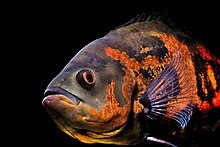Oscar (fish)
| Oscar | |
|---|---|
 |
|
| Scientific classification | |
| Kingdom: | Animalia |
| Phylum: | Chordata |
| Class: | Actinopterygii |
| Order: | Perciformes |
| Family: | Cichlidae |
| Genus: | Astronotus |
| Species: | A. ocellatus |
| Binomial name | |
|
Astronotus ocellatus (Agassiz, 1831) |
|
The oscar (Astronotus ocellatus) is a species of fish from the cichlid family known under a variety of common names, including tiger oscar, velvet cichlid, and marble cichlid. In tropical South America, where the species naturally resides, A. ocellatus specimens are often found for sale as a food fish in the local markets. The fish has been introduced to other areas, including China, Australia, and the United States. It is considered a popular aquarium fish in Europe and the U.S.
The species was originally described by Louis Agassiz in 1831 as Lobotes ocellatus, as he mistakenly believed the species was marine; later work assigned the species to the genus Astronotus. The species also has a number of junior synonyms: Acara compressus, Acara hyposticta, Astronotus ocellatus zebra, and Astronotus orbiculatus.
A. ocellatus examples have been reported to grow to about 45 cm (18 in) in length and 1.6 kilograms (3.5 lb) in weight. The wild-caught forms of the species are typically darkly coloured with yellow-ringed spots or ocelli on the caudal peduncle and on the dorsal fin. These ocelli have been suggested to function to limit fin-nipping by piranha (Serrasalmus spp.), which co-occur with A. ocellatus in its natural environment. The species is also able to rapidly alter its colouration, a trait which facilitates ritualised territorial and combat behaviours amongst conspecifics. Juvenile oscars have a different colouration from adults, and are striped with white and orange wavy bands and have spotted heads.
A. ocellatus is native to Peru, Ecuador, Colombia, Brazil, and French Guiana, and occurs in the Amazon River basin, along the Amazon, Içá, Negro, Solimões, and Ucayali River systems, and also in the Approuague and Oyapock River drainages. In its natural environment, the species typically occurs in slow-moving white-water habitats, and has been observed sheltering under submerged branches. Feral populations also occur in China, northern Australia, and Florida, USA as a byproduct of the ornamental fish trade. The species is limited in its distribution by its intolerance of cooler water temperatures, the lower lethal limit for the species is 12.9 °C (55.22 °F).
...
Wikipedia
